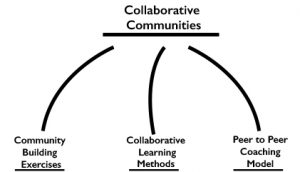Collaborative Communities
“The greatness of a community is most accurately measured by the compassionate actions of its members.”
–Coretta Scott King“If you want to go quickly, go alone. If you want to go far, go together.”
–African Proverb
Collaborative Processes for Communities A collaborative community opens the learning community to building relationships with and from one another. Like any learning, intentionality is important with implementation for the methods of learning. The collaborative processes for community includes community building exercises, peer to peer coaching and collaborative learning methods:
A collaborative community opens the learning community to building relationships with and from one another. Like any learning, intentionality is important with implementation for the methods of learning. The collaborative processes for community includes community building exercises, peer to peer coaching and collaborative learning methods:
Community Building Exercises
Building community exercises is about building the whole community for understanding one another, learning how to collaborate together, developing listening for learning, and other methods for the whole school community collectively learning with one another.
Read More
Peer to Peer Coaching
Peer to Peer Coaching is about teachers creating their own professional coaching community. It focuses on regularly observing each other throughout the whole school with a focused protocol to support seeing each other’s professional skills. The goal is learning professionally from one another in quest of the finest craft and pedagogy for successful student outcomes.
Read More
Collaborative Learning Methods
Collaborative learning is a relationship among students (and teachers with teachers) that requires positive inter-dependence (a sense of sink or swim together), individual accountability (each of us has to contribute and learn), interpersonal skills (communication, trust, leadership, decision making, and conflict resolution), face-to-face pro-active interaction, and processing(reflecting on how well the team is functioning and how to function even better).
Read More
Research on Community (Social Capital)
Serena J. Salloum, Roger D. Goddard & Dan Berebitsky (2018):
Resources, Learning, and Policy: The Relative Effects of Social and Financial Capital on Student Learning in Schools, Journal of Education for Students Placed at Risk (JESPAR), DOI:10.1080/10824669.2018.1496023
“We need intentional effort by schools to build social capital. We can’t leave it to chance.”
“Social capital was not only more important to learning than instructional expenditures, but also more important than the schools’ poverty, ethnic makeup or prior achievement,” Goddard said. While social capital tended to go down in schools as poverty levels increased, it wasn’t a major decrease. “We could see from our data that more than half of the social capital that schools have access to has nothing to do with the level of poverty in the communities they serve,” he said. “Our results really speak to the importance and the practicality of building social capital in high-poverty neighborhoods where they need it the most.”
Research Paper Abstract
In this paper, we note the contrasting positions occupied by social and financial capital in state and federal education policy and compare their relative impacts on student learning. To make such a comparison, we analyzed data from a representative sample of Michigan’s elementary schools using multilevel structural equation modeling to examine the relationships among social capital, instructional expenditures, and student achievement. We found that the level of social capital characterizing schools was not a function of instructional expenditures. We also found that both social and financial capital had a positive and significant relationship with reading and mathematics student achievement. However, the effect of social capital was three and five times larger than that of financial capital on mathematics and reading, respectively. We discuss the implications of these findings for education policy and programs that might improve student learning by strengthening social relationships.
Keywords: social capital, community, student achievement, relationship, education policy
